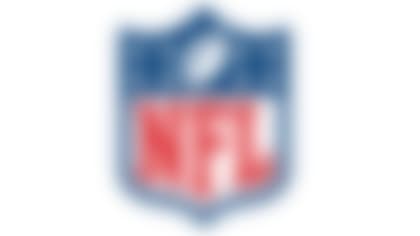NFL Media's Albert Breer touches on multiple topics in his exclusive Inside the NFL Notebook, including (click on each link to go directly to the topic):
» Where Peyton Manning could end up -- in an executive role -- as soon as next year.
» Two must-see college prospects on the national stage this Saturday.
» One big key to Andy Dalton's stellar play in 2015.
And much more, beginning with a contemporary challenge for NFL players and coaches in 2015 ...
Bill O'Brien's introduction to America didn't come through his first press conference at Penn State, or any sort of glory-splattered moment during one of four playoff runs when he was climbing the ladder as a New England Patriots assistant.
"You can't believe when the play doesn't work," O'Brien recalled. "So in that particular instance, and there were other instances, the play didn't go the way you wanted it to go and you butt heads a little bit. But what people have to remember about that one is, five seconds after that happened, we were looking at the pictures because we were getting ready to go to overtime with the Redskins. Luckily, Jerod Mayo intercepted a pass to seal the game. But we were preparing for the next part of the game."
As you might imagine, no one really remembers Brady and O'Brien reviewing the printouts.
That's the NFL of this era, and 2015 has had its share of these kinds of moments.
There was embattled Cowboys defensive end Greg Hardy crashing a special-teams summit two weeks ago. Last week, we had the normally-level B.J. Raji getting into a sideline shoving match with teammate Ha Ha Clinton-Dix. And on Thursday, Dez Bryant's post-practice confrontation with a reporter in the Cowboys' locker room was captured for America to see.
According to the NFL, the broadcast networks carry a minimum of eight cameras into every game with the capability for that number to bulge to 25. Then, there are the local television cameras on the sideline, and NFL Films cameras, and mics picking up sound all over the place. And these days, thanks to smartphones, there are tens of thousands of photo journalists doubling as paying customers.
"At this point, it's almost like, if you're in the stadium, you're working on the premise that you're on camera," one veteran assistant head coach said. "It's especially when the game is going on, but even before and after the game. ... And when emotions are running high and juices are flowing, you can definitely lose sight of it. Emotions take over, you're no longer thinking about it. Now, Hardy's a jackass, so he's an exception, but a lot of this stuff happens all the time, like the Clinton-Dix thing.
"As a coach, you can get caught up in it. And the funny thing is, I think the new wave of players actually have a little better sense of it, because they grew up with camera phones."
Football coaches are fond of saying "the eye in the sky don't lie." In this case, sometimes, it does.
Two years ago, Rams defensive end Chris Long was ejected from a game against the Panthers for throwing a punch. As he was exiting the stadium, a couple beer bottles flew at him. He caught one of the culprits, found a security guard and pointed at the pitcher of the pilsner. Another fan took a picture on his phone from a distance. It was grainy, and the assumption was made Long giving the fans a one-finger salute.
Long said in retrospect, he probably should've kept his head down and just walked out of the stadium. Lesson learned.
"I'm not a premier player -- I'm a lineman. But I assume someone's always watching or listening," Long said. "You can't always be worried about the cameras, but as a general rule, don't act a certain way that you wouldn't want broadcast on national TV or the radio. ... As we've become more visible, it's multiplied."
And social media has, in effect, thrown a stick of dynamite in the fireplace: "I wish I could have about a thousand of my tweets back," Long said, laughing. "I'm so glad I didn't have Twitter at 18."
Twitter (and the like) can add another layer to stuff caught on camera. It can also be a problem on its own.
Sammy Watkins felt the brunt of that last month, when, after he told the Buffalo News that he wanted more touches, the second-year Bills wideout took to Instagram to retaliate to criticism. Watkins understands now what he did wrong. And he also realizes where, once he logged on, he began the process of losing control of the message.
"I hate social media now," Watkins told me Tuesday. "It's getting to the point where everyone is with you or against you. And even if you're doing good, you still have people against you. It's like no one wants to understand your side -- you really don't have a voice as an athlete. We have no voice."
The overarching theme here is, whether it's on the sideline or the Internet or in the locker room in the middle of the week, it's safe for NFL players and coaches to guess they always have eyes on them.
And some thing's won't change. It's an emotional game, with a lot (money, jobs, legacies) on the line every week. There will be confrontation. That's accepted, too.
But there's a line.
One AFC head coach said he draws his at anything getting physical, or respect breaking down. If some crappy luck intervenes, and something is caught that looks worse than it is -- as it was in the Brady/O'Brien kerfuffle -- that's just the price of doing business on the Broadway of pro sports.
"There are more cameras now, more mics, players are mic'd up, they're gonna catch more stuff," the head coach explained. "Guys on your team mic'd for your network and your organization. There are cell phones all over the place, people in the stands can record things. There's just much more exposure. ... That's the world today. You're always two seconds away from something being out there, even in a football game. That's today's society."
The coach then added, "Hey, we only have so much time to change things and fix things. So that may not look perfect to the outside world."
Many in the NFL would tell you, it rarely does.
Four downs
1) Peyton's presence looms. Most believe Peyton Manning will hang 'em up after this season. Well, there's also a widely held assumption in NFL circles that -- with all the turnover expected to come across the league in January -- Manning could well re-emerge as a leading executive in 2016. The most bandied about landing spots are Cleveland (because of Manning's relationship with Browns owner/University of Tennessee booster Jimmy Haslam) and Tennessee (because of Manning's connections to the university, and his wife's presence as part owner of the Memphis Grizzlies), with Indianapolis (his longtime home) and New Orleans (his native soil) not to be completely discounted. The larger question here is how effective an ex-player can be moving quickly into a powerful decision-making role. It has worked in the NBA and MLB, but there's not as much history with it in football. In fact, the place where it's worked best might be where Manning is now: Denver. And so I dug back into my notes and through a conversation I had with Broncos president Joe Ellis shortly after John Elway was hired as executive vice president of football operations back in 2011. "I think the biggest thing that needed to be fixed was football leadership," Ellis told me then. "We had a void in that area. We needed someone who had the right competitive fire, who could draw respect, and come in and oversee all of football for Pat Bowlen. You can have a strong head coach, or a strong general manager, and have them report directly to the owner. That can be successful. But this is the way we're going." Elway, for his part, wasn't as inexperienced as Manning would be. The Bronco legend ran Denver's Arena Football League franchise for a time, served as a consultant to Bowlen in the five years leading up to his hire, and brought business experience from his chain of car dealerships. But it does seem that some of the things that the Broncos wanted in Elway -- see: football leadership -- Manning might be able to bring. One key for Manning, of course, would be an ability to "know what you don't know," something Elway showed in learning the scouting side of the business. But it's easy to figure someone with Manning's football acumen would be able to figure things out on the fly, so long as the right structure existed around him. And it's equally simple to see why, like Elway was for Denver, Manning might be an enticing risk for someone.
2) Brown out? In a lot of NFL markets, the trade deadline was just another tease -- with the logistics of the sport tearing down any wishes of splashy player movement. In Cleveland, it was another chance to shine a light on the trouble with its city's football operation. It was made clear to other clubs ahead of the deadline that the Browns were open for business. Some of their pieces drew serious interest (Joe Thomas, Paul Kruger). Other pieces didn't (Barkevious Mingo). But the common thread was what one rival executive referred to as a "very Cleveland" process. Most notable, in the eyes of other clubs, was the trouble in figuring out who was carrying the hammer. For example, one club called general manager Ray Farmer trying to gauge what it would take to wrest away a prominent player, and Farmer said he had to check in with others in the building. And when things got serious on any player, the price tags wound up being prohibitively high. Add it up, and you'll see a picture of a club with reason to blow it up and stockpile picks, carrying attractive chips to pull that off -- yet acting far too indecisively when the heat was turned up. For their part, internally, the Browns don't see chain of command having been much of an issue over the last few months, and believe the failure to pull off deals was simply a matter of compensation not matching the value of the players in question. But any such issues with the current structure could be a motivation for Haslam to seek an Elway-like figure after the season. He tried that when he tabbed Joe Banner in 2012, but the toxicity between GM Mike Lombardi and Banner, and Lombardi and coach Rob Chudzinski sent that regime off the rails before it could really get started. In hiring first-timers Farmer and Mike Pettine in 2014, Haslam went the other way, establishing a system more based on checks-and-balances than one man's vision. What's next? It's Cleveland, so that's anyone's guess.
3) Seahawks lurking. The murmurs over what's wrong in Seattle are considerably quieter this year than they were last year, and that's for good reason -- 4-4 doesn't seem like such a horrible spot to be in when 3-3 in 2014 became a 12-4 precursor to another trip to the Super Bowl. But the Seahawks also can't just snap their fingers and expect that to happen again. And talented as Seattle is, there are things to clean up. According to the guys there, the bye week was as it has been over Pete Carroll's six years at the helm, with some specific points of emphasis mixed in. On offense, coming off the team's Super Bowl goal-line failure, issues closing out drives have plagued Seattle in 2015. The Seahawks rank dead last in red-zone touchdown percentage (reaching the end zone on only five of 17 trips), giving them an easily identifiable area to target. Meanwhile, the defense isn't creating turnovers the way it has in the past -- ranking 23rd with nine takeaways. And, as one Seahawk on that side points out, "We are top three in most categories, and a point away from being No. 1 in scoring. So we'll just keep chopping wood." (Indeed, Seattle is second in total defense, third in yards allowed per play, second in pass defense, first in first downs allowed, and third in third-down defense.) And there is, too, an overall hurdle to clear: The team's ability to finish games, which was another Seahawk specialty the last couple years. Seattle has held fourth-quarter leads in all eight of its games, and Michael Bennett wondered aloud to me in September whether there was a hangover from February in that respect. The good news? Internally, all this is viewed as incredibly fixable. Another Seahawks source said, "The guys here feel like once they play for each other the way they know they can, there's something really strong here." The Cardinals should provide a good test of that on Sunday night.
4) Big injury catching up to Green Bay.Aaron Rodgers is one of those quarterbacks who probably could get to 10 wins with just about anyone's roster. (Tom Brady might be the only other one.) But even Rodgers feels the effects of losing a star player like Jordy Nelson. It didn't show up much in the first six games (all wins). It did the last two weeks (losses in Denver and Charlotte). Yes, Rodgers held the ball, but that was largely a result of defenses knowing they could win with their back end matching up against the Packers' skill players. "You're seeing a lot of 4-under, 3-deep looks -- that takes away the downfield throws and forces Aaron to throw short," one NFC pro scouting director said. That defensive approach puts stress on the less-experienced receivers to find dead spots. And if they can't, the stress is on Rodgers to throw into tight quarters. One Packer source said that "overall execution" needs to be turned up a notch with Nelson gone, which is a clichéd way of saying the ship needs to be tighter because losing Nelson shrinks the offense's margin for error. And that's tough when the offense's best skill player left, Randall Cobb, is better used as a gadget guy, and the younger receivers are struggling to break through.
Three checkdowns
1) The Steeler offense's ability to survive the extended absences of Kelvin Beachum, Maurkice Pouncey, Ben Roethlisberger, Le'Veon Bell and Martavis Bryant for stretches this season has been, in large part, thanks to the malleability of coordinator Todd Haley. And we could see that again, as we did earlier in the season, if Roethlisberger sits and Landry Jones plays on Sunday. When Big Ben hasn't been under center, Haley has taken the responsibility of setting protections off the quarterback's plate -- handing it to the center -- and emphasized getting the ball out quicker. That's part of the reason Pittsburgh was able to go 2-2 with Mike Vick and Jones earlier in the year, and why they persevered without Roethlisberger down the stretch last Sunday to beat a game Oakland team.
2) Progress remains steady in getting the NFL back to Los Angeles. During Wednesday's session in New York, the existing markets of the three interested teams -- St. Louis, Oakland and San Diego -- made presentations to the league's L.A. committee, with a contingent from the team in question in the room (awkward!). And while some might look at these presentations as virtual Hail Marys to keep teams home, they are important. While L.A. is Priority No. 1 for the league, some owners are leery about allowing a team to bend the relocation guidelines to move, and the antitrust implications that could result (such as teams being free to move without approval from the league in the future). As a reminder, the important guideline in this regard: The club must prove that its existing market has failed.
3) Speaking of L.A., we're now at the point where it's worth keeping an eye on what's happening in St. Louis and San Diego. Charger players and coaches have taken note how their stadium is becoming increasingly overrun with visiting fans. The Rams are last in the NFL in attendance, and the only team averaging under 80 percent capacity. Only three other teams are under 90 percent for the season. Oakland's issues are less pronounced because of its unique fan base and renaissance season, but the Raiders still are one of those three, with only Washington and St. Louis posting a lower percentage of attendance. Based on the circumstances, of course, it's pretty hard to blame the fans.
Two college players to watch Saturday
1) Baylor WR Corey Coleman (vs. Oklahoma, 8 p.m. ET, ABC): The junior's numbers look like they were compiled on PlayStation to begin with: 58 catches for 1,178 yards and 20 touchdowns. Now, consider that Coleman piled all of that up in eight games. "He doesn't know how to run routes because ... Baylor," said one area scout assigned to the Bears. "But he's athletic with very good hands and you can't argue with the production. ... They get guys wide open, and they have a number of receivers who can beat you. And Big 12 defenses have never been worse. But he's a really talented athlete, probably the best to come out of there since Kendall Wright." An AFC exec echoed the concern over the system -- "That offense usually doesn't put out great pros" -- and added that Coleman's size (listed at 5-11 and 190 pounds) could be an issue. But Coleman's build is similar to Wright's, and while linemen and quarterbacks haven't translated well from Baylor to the NFL, receivers have actually done better, with Wright, Josh Gordon and Terrance Williams having produced at the pro level. And because of that, it's worth taking a long look here, with this being a good week to do so, given the talent Oklahoma brings to the table and the stage this one will be played on.
2) Memphis QB Paxton Lynch (at Houston, 7 p.m. ET, ESPN2): Physically, Lynch has drawn comparisons to Joe Flacco (with a little more athleticism and a little more arm). Conceptually, he's getting compared to Blake Bortles -- because so many in the NFL are now scrambling to learn about this late bloomer, the same way they were cramming on the former UCF quarterback in 2013. One AFC area scout assigned to Memphis said, "No one's really studied him, but you see the talent. You go into Memphis to see the offensive lineman and the senior receiver, and then you look at the quarterback, and he's got arm strength and athletic ability, he's long. It's a little scary. He was decent last year, and this is kind of like Bortles, where he just wasn't on anyone's radar." Lynch packed 20 extra pounds onto his lanky 6-foot-7 frame between last year and this year, and has thrown for 3,014 yards and 19 touchdowns (against just two picks) in Justin Fuente's spread through nine games. One NFC exec said, in a live look, he saw "a good arm and athleticism for a bigger guy, accuracy looked pretty good, and he certainly looked to have the tools to play the position." While there are still a lot of rocks to turn over on Lynch, who has yet to announce his draft intentions, he's definitely shoved his way into the QB conversation with guys like Michigan State's Connor Cook and Cal's Jared Goff.
Extra point
At one point during the Bengals' scintillating Week 5 win over Seattle, the Cincinnati offensive coaches stationed high above in the box had a heck of an "OH CRAP" moment.
Andy Dalton had just thrown a pick, and he was parked by himself on the bench. At that point, it was fair to worry about Dalton going in the tank. As one Bengals assistant said, "We just wondered why he'd be all by himself like that during such [a] critical stretch."
Dalton then popped to his feet. His head had been down, yes ... But only because he was looking at what was on his tablet. And when he found what he was looking for, to use as a teaching tool to a teammate, he grabbed one of his receivers by the collar and made the correction that the Bengals needed.
That afternoon, Cincy surmounted a 17-point, fourth-quarter deficit to thwart the NFC champs. And that day, as much as any, provided signs of the new Dalton.
"Commanding receivers be where that daggone play says they gotta be, and to run things the way he wants them run, that's the new part of him," left tackle Andrew Whitworth told me. "He feels good enough and comfortable enough in his skin to hold guys accountable, and not just holding himself accountable. ... He's finally hit that part of his career where he's like, 'Man, this is the difference. If all the pressure is on me, I gotta carry that pressure on to the guys to play well around me.' "
Dalton has posted six plus-100 quarterback ratings through eight games -- tying his career high for a 16-game season. Last week, he began to get the prime time monkey off his back in the team's blowout win over the Browns. And over the next two games, Dalton gets a Monday nighter (vs. Houston) and Sunday night contest (at Arizona) to further exorcise those demons.
Of course, the real questions that everyone has for Dalton won't be -- can't be -- answered until January.
But with 76 NFL starts (including the playoffs) under his belt, this version of No. 14 appears to be more prepared for that stage. You can see it in his synergy with offensive coordinator Hue Jackson and the scheme, as well as his ability to impose his will not just on opponents, but his teammates. As Dalton explains it, the corrections he would once make on Monday or Wednesday, he's now able to make in real time, which has added a layer of confidence to his demeanor.
"It comes down to where sometimes I had to go back and see things and make sure what I was telling them was exactly right -- I wanted to make sure the film matched what I was thinking," Dalton said. "Now, I know. It's one of those things, it's been a point of emphasis for making sure we correct it out there on the field, rather than going back into film room. I think it's made us better."
His teammates would certainly agree.
"He's not afraid to tell you exactly what he wants -- even if it's right in front of people," tight end Tyler Eifert said. "He'll call you out and make sure it's right, which is a good thing. It keeps everyone accountable, it keeps everyone held to a high standard."
And it also is sure to keep his coaches at ease the next time they see something a little different from their captain on the sideline.
Follow Albert Breer on Twitter @AlbertBreer.



